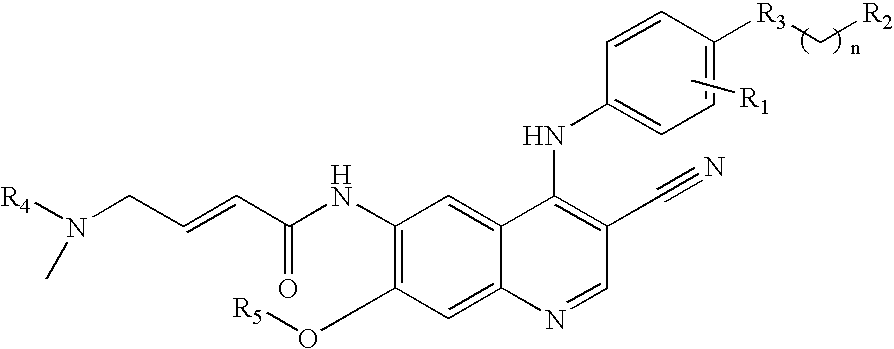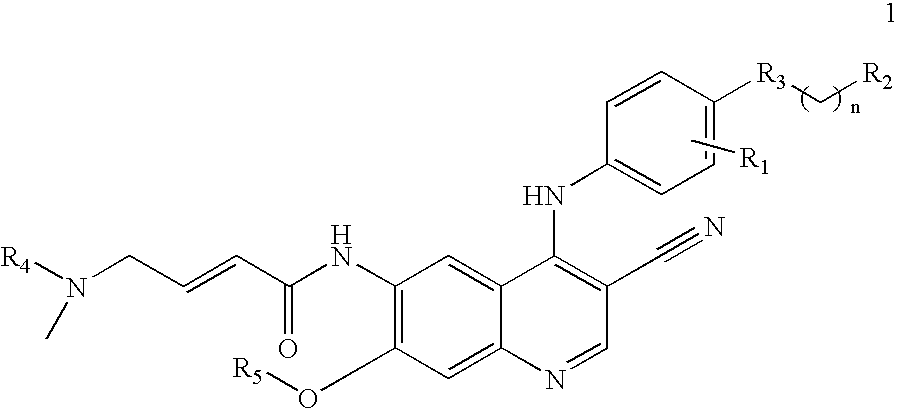Protein tyrosine kinase enzyme inhibitors
- Summary
- Abstract
- Description
- Claims
- Application Information
AI Technical Summary
Problems solved by technology
Method used
Image
Examples
example 1
(E)-N-{4-[4-(benzyloxy)-3-chloroanilino]-3-cyano-7-ethoxy-6-quinolinyl}-4-(dimethylamino)-2-butenamide
[0042]A 1.74 ml (2.54 g, 0.02 moles) portion of oxalyl chloride was added to 3.31 grams (0.02 moles) of (E)-4-(dimethylamino)-2-butenoic acid hydrochloride in 75 ml of acetonitrile. To this was added a small drop of dimethylformamide. The reaction was heated and stirred in an oil bath at 63° for 20 minutes, giving an orange solution. This solution as concentrated in vacuo without the application of heat to about half its original volume. This solution was cooled in an ice bath and a solution of 4.45 g (0.01 moles) of the 6-amino-4-[4-(benzyloxy)-3-chloroanilino]-7-ethoxy-3-quinolinecarbonitrile in 50 ml of N-methylpyrrolidone was added in a stream. The reaction was cooled and stirred for 2 hours. The reaction was poured onto 100 ml of saturated aqueous sodium bicarbonate in ice. On standing the resulting gum solidified and the solid was filtered. This solid was chromatographed on si...
example 2
(E)-N-{4-[3-chloro-4-(2-pyridinylmethoxy)anilino]-3-cyano-7-ethoxy-6-quinolinyl}-4-(dimethylamino)-2-butenamide
[0043]A solution of (E)-4-(dimethylamino)-2-butenoic acid hydrochloride in 1.2 L of tetrahydrofuran (THF) and a catalytic amount of dimethylformide (DMF) (1.2 ml) was cooled to 0-5° C. Oxalyl chloride (0.95 eq) was added dropwise and the mixture was warmed to 25-30° C. and stirred for 2 hours. The orange suspension was checked for complete consumption of oxalyl chloride by HPLC then cooled to 0-5° C. A solution of 111 g of 4-[4-(2-pyridylmethoxy)-3-chloro]amino-6-amino-3-cyano-7-ethoxyquinoline in 1.47 L of 1-methyl-2-pyrrolidinone was added dropwise and the mixture was stirred until ≦1.0% of the starting aniline remained (3-16 hours). The reaction was quenched with water and the mixture was warmed to 40° C. Aqueous sodium hydroxide was added to bring the pH to 10-11. The resulting precipitates were filtered hot and washed with water. The wet solids were heated to reflux (7...
example 3
(E)-N-(4-{3-chloro-4-[3-fluorobenzyl)oxy]anilino}-3-cyano-7-ethoxy-6-quinolinyl)-4-(dimethylamino)-2-butenamide
[0044]A solution of 108 g (E)-4-(dimethylamino)-2-butenoic acid hydrochloride in 1.1 L of tetrahydrofuran (THF) and a catalytic amount of dimethylformide (DMF) (1.2 ml) was cooled to 0-5° C. Oxalyl chloride (0.95 eq) was added dropwise and the mixture was warmed to 25-30° C. and stirred for 2 hours. The orange suspension was checked for complete consumption of oxalyl chloride by HPLC then cooled to 0-5° C. A solution of 150 g of 6-amino-4-[3-chloro-4-(3-fluorobenzyloxy)]anilino-3-cyano-7-ethoxy quinoline in 1.5 L of 1-methyl-2-pyrrolidinone was added dropwise and the mixture was stirred until ≦1.0% of the starting aniline remained (3-16 hours). The reaction was quenched with water and the mixture was warmed to 40° C. Aqueous sodium hydroxide (101 g in 750 ml) was added to bring the pH to 10-11. The resulting precipitates were filtered hot and washed with water. The wet soli...
PUM
| Property | Measurement | Unit |
|---|---|---|
| morphology | aaaaa | aaaaa |
| pH | aaaaa | aaaaa |
| ionic strength | aaaaa | aaaaa |
Abstract
Description
Claims
Application Information
 Login to View More
Login to View More - R&D
- Intellectual Property
- Life Sciences
- Materials
- Tech Scout
- Unparalleled Data Quality
- Higher Quality Content
- 60% Fewer Hallucinations
Browse by: Latest US Patents, China's latest patents, Technical Efficacy Thesaurus, Application Domain, Technology Topic, Popular Technical Reports.
© 2025 PatSnap. All rights reserved.Legal|Privacy policy|Modern Slavery Act Transparency Statement|Sitemap|About US| Contact US: help@patsnap.com



